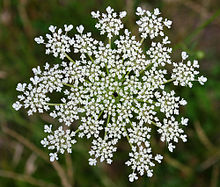Wild carrot
| Wild carrot | |
|---|---|
 |
|
| The umbel of a wild carrot | |
| Scientific classification | |
| Kingdom: | Plantae |
| (unranked): | Angiosperms |
| (unranked): | Eudicots |
| (unranked): | Asterids |
| Order: | Apiales |
| Family: | Apiaceae |
| Genus: | Daucus |
| Species: | D. carota |
| Binomial name | |
|
Daucus carota L. |
|
| Synonyms | |
|
|
Daucus carota, whose common names include wild carrot, bird's nest, bishop's lace, and Queen Anne's lace (North America), is a flowering plant in the family Apiaceae, native to temperate regions of Europe and southwest Asia, and naturalized to North America and Australia.
Domesticated carrots are cultivars of a subspecies, Daucus carota subsp. sativus.
The wild carrot is a herbaceous, somewhat variable biennial plant that grows between 30 and 60 cm (1 and 2 ft) tall, and is roughly hairy, with a stiff, solid stem. The leaves are tripinnate, finely divided and lacy, and overall triangular in shape. The flowers are small and dull white, clustered in flat, dense umbels. They may be pink in bud and may have a reddish flower in the centre of the umbel. The lower bracts are three-forked or pinnate, which distinguishes the plant from other white-flowered umbellifers. As the seeds develop, the umbel curls up at the edges, becomes more congested, and develops a concave surface. The fruits are oval and flattened, with short styles and hooked spines. The dried umbels detach from the plant, becoming tumbleweeds. The function of the tiny red flower, coloured by anthocyanin, is to attract insects.
Similar in appearance to the deadly poison hemlock, D. carota is distinguished by a mix of tripinnate leaves, fine hairs on its solid green stems and on its leaves, a root that smells like carrots, and occasionally a single dark red flower in the center of the umbel.
Like the cultivated carrot, the D. carota root is edible while young, but it quickly becomes too woody to consume.
Extra caution should be used when collecting D. carota because it bears a close resemblance to poison hemlock. In addition, the leaves of the wild carrot can cause phytophotodermatitis, so caution should also be used when handling the plant. It has been used as a method of contraception and an abortifacient for centuries.
...
Wikipedia
